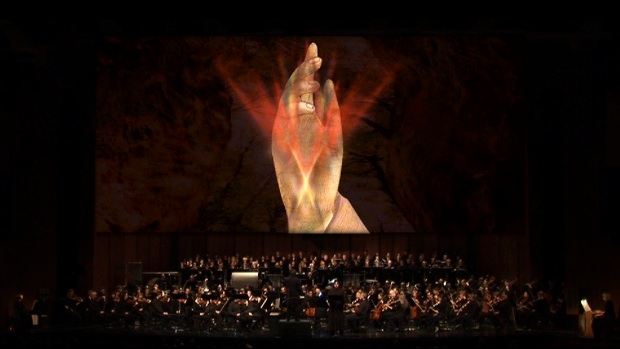Opera in Concert Versions
with Visual Creation :
a New Artistic Form

During the last years, concert with images have proliferated. Often for bad reasons : organizers are afraid that larger audiences, more and more shaped by the image culture (from television, passing by multimedia, to video games), would not be able to listen to music without the help of image.
They have been calling image power to rescue music, in order to attract larger audiences.
Such strategy can only fall short. It is obviously self-destructive of the artistic objects it produces, as soon as its necessity finds its source outside of artistic field. From an aesthetic point of view, it is also totally inacceptable, because it relies on a supposed constitutive weakness of music compared to image.
If it is true that it is nearly impossible to escape today to the domination of image, ubiquitous, pure music could temptated to constitutes itself as a resistance space, where the only prevailing images should be mental images build by the listener perception/cognition in listening situation, whether in concert or any other musical listening practice.
Therefore, to persevere in the confrontation of music and image, may seem a promethean challenge, emphatically sacrilegious, or simply bound to failure, according to the viewing – or listening ? – point where one stands.
The artistic challenge should be totally else: in the search for new cross forms between image and music, among which opera in concert with visual creation, may represent a particularly fertile path, by the pluridisciplinary nature of opera itself, which makes it a historic model for interdisciplinary creation.
But this requires that one accepts truly the artistic challenge which under lies such a form. To go straight to the essential: if image does not bring anything to the discourse, to the music, if it does not succeed to constitute a new organic totality with the music, it means it has no room in the project.
The worst case being when one dimension parasites the other, when image prevents to listen to the music.
The artistic challenge should not vanish behind a game of egos, where, between artists and composers, an unhealthy competition establishes itself, to know who, from one or the other, will gain the upper hand. Too many artistic collaborations fall into this trap, and lead to parallel discourses, which, whatever their respective merits, will never meet.
Opera in concert situation with visual creation represents a major challenge for art and music in the years to come. One should take advantage of this situation, which for economic reasons makes it so that there will be less and less operas productions with staging, and transform a bad reason in an opportunity for artistic creation.
But this should be realized with a maximal artistic rigor and exigency. And in the crossed, mutual respect and comprehension, of music and image.
Jean-Baptiste Barrière
